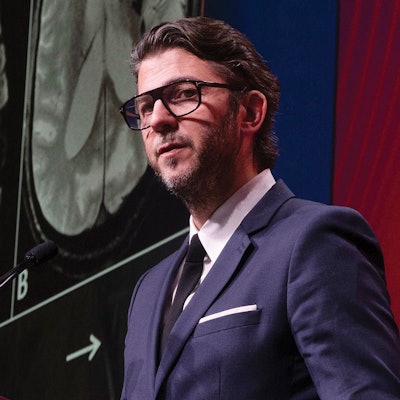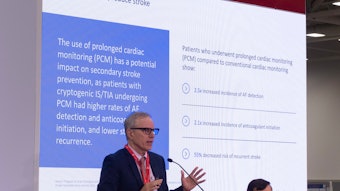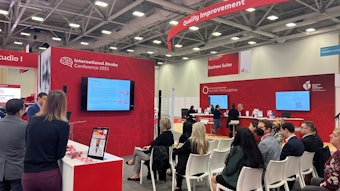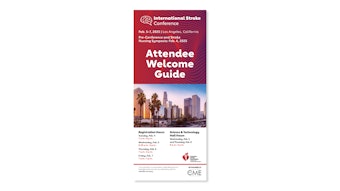Late-breaking results from five trials presented at Opening Main Event

At Wednesday’s Opening Main Event, researchers highlighted findings on minimally invasive surgery for intracerebral hemorrhage, transradial versus transfemoral angiography and outcomes of endovascular therapy for medium or distal vessel occlusion compared to medical management.
The trials found:
- Minimally invasive surgery for intracerebral hemorrhage did not improve longer-term patient outcomes.
- Transradial angiography offers advantages over transfemoral angiography.
- In patients receiving best medical treatment for medium or distal vessel occlusion, adding endovascular treatment did not reduce disability and death, the DISTAL trial found.
- Endovascular therapy provided no added benefit over usual care, results from the ESCAPE-MeVO trial showed for medium vessel occlusion.
- The DISCOUNT trial found mechanical thrombectomy wasn’t superior to usual care for treatment of distal vessel occlusion.
Surgery with the ARTEMIS device shows short-term benefit in patients with deep intracerebral hemorrhage
Intracerebral hemorrhage accounts for 10% of all U.S. stroke cases per year but 30% to 40% of early stroke mortality. In the MIND study, researchers explored whether minimally invasive surgery with the ARTEMIS Neuro Evacuation Device could improve outcomes in patients primarily with deep and lobar intracerebral hemorrhages. The ARTEMIS tool uses neuro-navigation and an endoscope to visualize and evacuate the hemorrhage through a tiny endoscope sheath. Its low-profile access has the potential to minimize injury to surrounding brain tissue.
MIND — a multicenter, open-label, randomized trial — studied patients with moderate to large volume (20-80 cc) supratentorial intracerebral hemorrhage who presented within 24 hours of symptom onset. The patients were randomized 2:1 to minimally invasive surgery with the ARTEMIS device and medical management as defined by the American Heart Association/American Stroke Association guidelines or to medical management alone.
The study’s primary effectiveness endpoint was a 180-day ordinal modified Rankin score (mRS). The primary safety endpoint was 30-day mortality. Cases were stratified for severity and intracerebral hemorrhage location. Fiorella
Fiorella
The Early Minimally Invasive Removal of ICH (ENRICH) trial recently demonstrated that minimally invasive surgery improves functional outcomes in patients with lobar intracerebral hemorrhage at 180 days. Based on a planned interim analysis, enrollment of patients with deep hemorrhages in the ENRICH trial was stopped early due to a lack of observed benefit in this subgroup, further underscoring the focus on patients with lobar hemorrhages. In the MIND study, enrollment was stopped after 236 patients, with 167 (70.8%) presenting with deep intracerebral hemorrhage and 72 (29.2%) with lobar intracerebral hemorrhage.
After minimally invasive surgery, intracerebral hemorrhage volume was reduced by 81.5% to 6.0 cc in the deep and 80.4% to 8.1 cc in the lobar cohorts, respectively. Despite improvement in functional outcomes at 30 days in both cohorts, however, minimally invasive surgery with the ARTEMIS device was not superior to medical management only.
“While minimally invasive surgery did not improve disability outcomes or reduce mortality at 180 days, we did see a substantial reduction in symptomatic perihematomal edema and improved modified Rankin scores at 30 days,” said MIND co-investigator David Fiorella, MD, PhD, director of the Cerebrovascular Center at Stony Brook University Hospital in New York. Fiorella also noted that fewer surgical patients were intubated, and they spent less time in the ICU and in the hospital at 30 days, compared with the medical management group.
“Our data suggests that minimally invasive surgery is effective at eliminating or reducing early reversible intracerebral hemorrhage damage but can’t reverse enough of the persistent damage to maintain the significance,” he said. “But with limited treatment options for reducing disability at 30 days and getting patients out of the ICU or hospital earlier, the ARTEMIS procedure remains a viable option, particularly for patients with deep intracerebral hemorrhage.”
Fiorella said significant advancements in our understanding of minimally invasive surgical techniques have been made since the MIND study began. The results of ongoing randomized clinical trials, like the Dutch ICH Surgery Trial, are likely to paint a clearer picture of whether endoscopic intracerebral hemorrhage evacuation improves long-term functional outcomes, he said.
Transradial angiography offers better patient-centered outcomes compared with transfemoral angiography
Although the transradial approach for cerebral angiography has gained popularity in recent years, evidence has been lacking regarding its efficacy and safety compared with the traditional transfemoral approach. The TRACE trial, a direct comparison of the efficacy and safety of the two approaches for cerebral angiography and neurointervention, found that the transradial approach provides notable advantages.
TRACE is an investigator-initiated, multicenter, open-label trial with blinded endpoint assessment. The trial randomized 858 patients scheduled for diagnostic cerebral angiography 1:1 to an intervention group (transradial angiography; 431 patients) or control group (transfemoral angiography; 427 patients). The study was conducted at 13 sites in China from September 2023 to November 2024. Ni
Ni
The primary endpoint, the success rate of diagnostic cerebral angiography, was lower in the transradial angiography group (91.0%, 392 patients) compared with the transfemoral angiography group (95.8%, 409 patients); incidence difference, −4.8% [95% CI, −8.1% to -1.5%]; RR, 0.95 [95% CI, 0.92-0.98]; P = 0.46).
Duration of both angiography and fluoroscopy was longer in the transradial group than in the transfemoral group. But patient bedridden time and visual analog scale score were lower in the transradial angiography group. Also, no significant difference was found between the groups in the incidence of angiographic complications during and within 24 hours after the procedure.
“Our findings offer valuable insights into these two access routes, helping to clarify the trade-offs between procedural success, patient comfort and complication rates, which are critical for informed clinical decision-making,” said principal investigator Wei Ni, MD, a neurosurgeon at Huashan Hospital and Fudan University in China.
“Although the transradial approach for cerebral angiography may have a slightly lower success rate and longer procedural time compared to the transfemoral approach, it provides notable advantages in patient comfort, shorter bedridden time and comparable complication rates.”
Ni noted that developing more efficient transradial angiography devices is essential for enhancing the success rate of transfemoral angiography.
Endovascular therapy did not provide an added benefit in patients with distal or medium vessel occlusion stroke
The DISTAL trial is one of the first and largest randomized-controlled trials reporting on the effect of endovascular thrombectomy (EVT) plus best medical therapy versus best medical therapy alone for patients with acute ischemic stroke due to a medium or distal vessel occlusion. Results of the trial described Wednesday showed that EVT did not reduce disability or death compared with the best medical therapy alone.
DISTAL — a multicenter, international, prospective, open-label, blinded-endpoint superiority trial — studied 543 patients 1:1 with an acute ischemic stroke due to a medium or distal vessel occlusion. The patients were randomized 1:1 to EVT plus usual careor usual care alone over three years. The primary efficacy outcome was the distribution of disability levels on the modified Rankin Scale at 90 days.  Psychogios
Psychogios
“Based on previous evidence, we limited the target vessels to previously understudied vessel segments in which evidence of a treatment benefit was missing, which included the non- or co-dominant M2 segment; M3 or M4 segment of the middle cerebral artery; the A1, A2 or A3 segment of the anterior cerebral artery; and the P1, P2 or P3 segment of the posterior cerebral artery,” said principal investigator Marios Psychogios, MD, director of diagnostic and interventional neuroradiology at University Hospital Basel in Switzerland.
Co-principal investigator Urs Fischer, MD, director of the neurology department at the University Hospital Bern in Switzerland, noted that the study’s limitation to non- or co-dominant M2 occlusions, which perfuse less than half of the media territory, is a key strength of the DISTAL trial compared with other trials. For dominant M2 occlusions, there was compelling evidence from a HERMES sub-analysis that endovascular therapy would be beneficial, he said.
Still, EVT in addition to best medical therapy did not lead to a reduction in disability or death compared with best medical therapy alone. This finding was consistent among all studied subgroups, particularly in patients with moderate to severe strokes with a National Institute of Health Stroke Scale score of 6 or above, people who did not receive intravenous thrombolysis, and those age 70 or younger. No patient was lost to follow-up.
Although the results of the DISTAL trial were neutral, the researchers suggest that clinicians should consider offering EVT to selected patients on a case-to-case basis. “Endovascular therapy in addition to best medical therapy does not lead to increased rates of symptomatic intracranial hemorrhage or death, and overall endovascular therapy for medium or distal vessel occlusion appears to be a safe procedure,” Dr. Psychogios said. “An important finding from DISTAL was that the natural course of medium distal vessel occlusion stroke is worse than expected, increasing the pressure on finding novel effective treatment options.” DISTAL will serve to inform the design of future randomized clinical trials studying the effects of EVT in people with distal or medium vessel occlusion stroke. The study was published simultaneously in the New England Journal of Medicine.
Endovascular therapy did not provide an added benefit in patients with medium vessel occlusion stroke
The ESCAPE-MeVO trial, reporting on the effect of endovascular thrombectomy (EVT) plus usual care for patients with acute ischemic stroke due to a medium distal vessel occlusion, found EVT did not provide an added benefit.
The study —a prospective, open-label, blinded-endpoint trial — included 530 patients in five countries who had an acute ischemic stroke due to a medium distal vessel occlusion (in A2, M2, P2 or more distal arterial segments). The patients were randomized 1:1 within 12 hours from the last known well/favorable baseline noninvasive brain imaging to EVT plus usual care (255 patients) or usual care only (274 patients). The study period ran from April 2022 to June 2024. Eligible patients in both treatment groups received guideline-directed anti-thrombolytic therapy. The primary outcome was the modified Rankin Scale (mRS) at 90 days. Secondary outcomes included the Barthel Index score, mortality at 90 days, infarct volume and patient reported quality of life. Goyal
Goyal
In the study, EVT treatment did not improve outcomes at 90 days, compared with usual care. Excellent functional outcomes (mRS 0-1 at 90 days) occurred in 41.6% of patients in the EVT group and 43.1% in the usual care group [adjRR = 0.95, CI 0.79-1.15, p=0.61]. In the EVT group, 13.3% of patients died, compared with 8.4% in the usual care group. Symptomatic intracranial hemorrhage occurred in 2.2% of patients in the usual care group and 5.4% of patients in the EVT group (p=0.08).
“Ten years ago, we tackled large vessel occlusion, showing in multiple scenarios that endovascular therapy treatment is good for patients with large vessel occlusion. In ESCAPE-MeVO, we asked the next question: ‘Is endovascular therapy efficacious when the clots are smaller and the strokes are less severe?’” said principal investigator Mayank Goyal, MD, FAHA, a clinical professor of radiology and clinical neurosciences at the University of Calgary Cumming School of Medicine in Alberta.
The answer could depend on the results of the two other landmark trials, DISTAL (see above) and DISCOUNT (below), evaluating the efficacy of EVT for the management of acute ischemic stroke with more distal occlusions, Dr. Goyal said. Differing results will necessitate an analysis of the trials’ differences to determine criteria for future trials.
“If the results are similar in all three trials, however, we may need to be more cautious in terms of how aggressive we are when selecting patients for endovascular therapy,” said ESCAPE-MeVO co-investigator Michael Hill, MD, director of the stroke unit for the Calgary Stroke Program. ESCAPE-MeVO findings were was published simultaneously in the New England Journal of Medicine.
Endovascular therapy did not provide an added benefit in patients with distal vessel occlusion stroke
Consistent with the DISTAL and ESCAPE-MeVO trial results, the DISCOUNT trial, reporting on the effect of mechanical thrombectomy plus usual care for patients with acute ischemic stroke due to distal vessel occlusion, found mechanical thrombectomy did not provide an added benefit. The open-label trial involving 22 French University hospitals randomized 488 patients with acute ischemic stroke involving the anterior or posterior circulation secondary to a distal vessel occlusion within six hours of symptom onset or within 24 hours if no hypertensive signal on fluid attenuation inversion recovery acquistion 1:1 to mechanical thrombectomy with best medical treatment or best medical therapy alone. The primary outcome was the rate of good clinical outcome defined as a mRS ≤2 at three months and evaluated by an independent assessor blinded to the intervention arm. An interim analysis was planned at the end of the follow-up of the first 163 patients randomized, with a stopping rule for futility defined as a conditional power of <30%. Clarencon
Clarencon
In the control group, 77% of patients (59/77 patients) observed a mRS ≤2 at three months versus 60% (45/75 patients) in the experimental arm. Intracranial hemorrhage was reported in 28 patients in the control arm (29%) and 28 patients in the experimental arm (44%).
“The DISCOUNT trial was stopped after the analysis of the first 163 randomized patients because results seemed to disfavor mechanical thrombectomy, and due to a safety issue and the low conditional power of 6.3%,” said Frédéric Clarençon, MD, PhD, head of interventional neuroradiology at the Pitié Salpêtrière Hospital in Paris, the study’s principal investigator.











